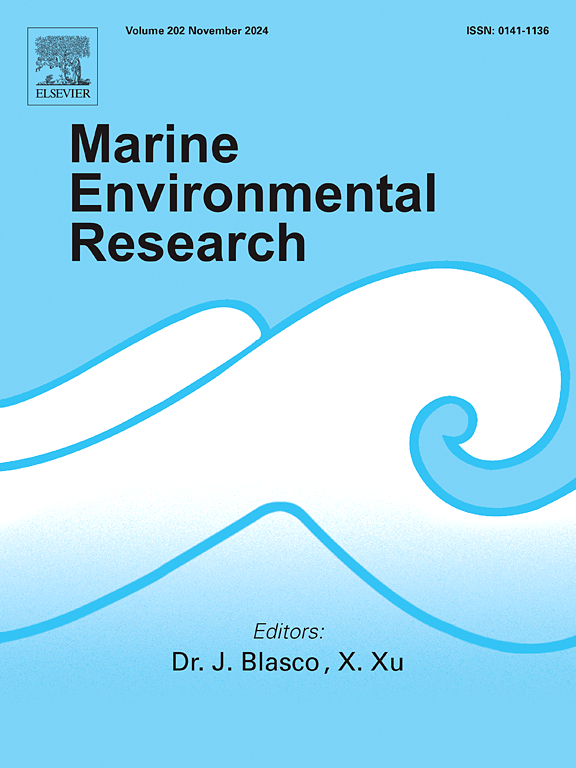Impact of climate change to the potential habitat distribution of three cephalopod species from offshore of Zhejiang
IF 3
3区 环境科学与生态学
Q2 ENVIRONMENTAL SCIENCES
引用次数: 0
Abstract
Cephalopods are predominantly short-lived marine organisms, and their habitats are more susceptible to the effects of climate change. Modelling and predicting the distribution of potential habitats of cephalopods and their changing habitat spatial patterns under climate change scenarios can provide an essential scientific foundation for cephalopod habitat conservation and fisheries ecosystem management in the context of climate change. The trawl survey data collected along Zhejiang offshore in the spring and autumn of 2017–2023, in conjunction with marine environmental data including sea surface temperature (SST), sea surface salinity (SSS), dissolved oxygen concentration (DO) and chlorophyll-a concentration (CHLA), collected by temperature-salt-depth instrument, were employed to simulate and predict the potential habitat distribution of Uroteuthis duvauceli, Abralia multihamata, and Sepiella maindroni in the four RCP climate scenarios in 2100 by random forest as a species distribution model. The results demonstrated that the Random Forest predictions were accurate and reliable, with an AUC exceeding 0.8 for each group and a standard deviation below 0.05. The main environmental factors affecting the habitat distribution of three cephalopod species are SST and SSS, with an average contribution rate of 0.28 in spring and 0.33 in autumn. The average contribution rate of SSS in spring is 0.32, and in autumn it is 0.29. The response curves demonstrated that the three cephalopod species exhibited varying degrees of response to changes in SST and SSS. During the spring period, the optimal habitat for cephalopods was characterised by SST ranging from 18 °C to 20 °C, and SSS exceeding 28 ‰. In contrast, in autumn, S. maindroni exhibited a preference for warmer water compared to U. duvauceli and A. multihamata. The potential habitat suitability zones of cephalopods under high gas emission scenarios were found to mainly extend to the southern and northern coast of Zhejiang. Among them, the area of the high adapted zone of S. maindroni increased by 352 % in the RCP4.5 scenario, the area of the high adapted zone of U. duvauceli increased by 69 % in the RCP4.5 scenario, and the area of the high adapted zone of A. multihamata increased by 69 % in the RCP8.5 scenario. The centroid changes of the three species of cephalopods were not found to be significant in the high suitability zones of the three cephalopod species in different climatic scenarios. The present study proposes that climate change will result in alterations to the potential habitat of cephalopods offshore Zhejiang, which is a significant consideration for the future conservation and management of cephalopod fisheries.
气候变化对浙江近海三种头足类潜在生境分布的影响
头足类动物主要是短命的海洋生物,它们的栖息地更容易受到气候变化的影响。气候变化情景下头足类潜在栖息地分布及其空间格局变化的建模与预测,可为气候变化背景下头足类栖息地保护和渔业生态系统管理提供重要的科学依据。利用2017-2023年春季和秋季浙江近海拖网调查资料,结合温度-盐深仪采集的海表温度(SST)、海表盐度(SSS)、溶解氧浓度(DO)和叶绿素-a浓度(CHLA)等海洋环境数据,模拟和预测了杜华尾尾鱼(Uroteuthis duvauceli)、多哈布利亚(abalia multihamata)、2100年4种RCP气候情景下,以随机森林为物种分布模式的麦氏单胞菌(Sepiella maindroni)。结果表明,随机森林预测准确可靠,每组的AUC均超过0.8,标准差均小于0.05。影响3种头足类生境分布的主要环境因子是海温和海温,春季和秋季的平均贡献率分别为0.28和0.33。春季SSS平均贡献率为0.32,秋季SSS平均贡献率为0.29。响应曲线表明,三种头足类动物对海温和SSS的变化有不同程度的响应。春季头足类最适栖息地海温在18 ~ 20℃,SSS大于28‰;相反,在秋季,与杜华花鲈和多花鲈相比,美氏花鲈表现出对温暖水域的偏好。高排放情景下头足类动物的潜在生境适宜带主要向浙南、浙北沿海延伸。其中,在RCP4.5情景下,maindroni高适应区面积增加了352%,在RCP4.5情景下,duvauceli高适应区面积增加了69%,在RCP8.5情景下,多花蒿高适应区面积增加了69%。三种头足类动物在不同气候情景下的高适宜性区,质心变化不显著。气候变化对浙江近海头足类潜在栖息地的影响是今后头足类渔业保护与管理的重要考虑因素。
本文章由计算机程序翻译,如有差异,请以英文原文为准。
求助全文
约1分钟内获得全文
求助全文
来源期刊

Marine environmental research
环境科学-毒理学
CiteScore
5.90
自引率
3.00%
发文量
217
审稿时长
46 days
期刊介绍:
Marine Environmental Research publishes original research papers on chemical, physical, and biological interactions in the oceans and coastal waters. The journal serves as a forum for new information on biology, chemistry, and toxicology and syntheses that advance understanding of marine environmental processes.
Submission of multidisciplinary studies is encouraged. Studies that utilize experimental approaches to clarify the roles of anthropogenic and natural causes of changes in marine ecosystems are especially welcome, as are those studies that represent new developments of a theoretical or conceptual aspect of marine science. All papers published in this journal are reviewed by qualified peers prior to acceptance and publication. Examples of topics considered to be appropriate for the journal include, but are not limited to, the following:
– The extent, persistence, and consequences of change and the recovery from such change in natural marine systems
– The biochemical, physiological, and ecological consequences of contaminants to marine organisms and ecosystems
– The biogeochemistry of naturally occurring and anthropogenic substances
– Models that describe and predict the above processes
– Monitoring studies, to the extent that their results provide new information on functional processes
– Methodological papers describing improved quantitative techniques for the marine sciences.
 求助内容:
求助内容: 应助结果提醒方式:
应助结果提醒方式:


